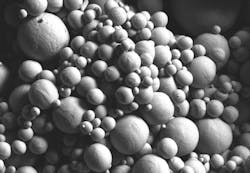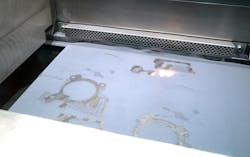Sustainable Methods for Metal AM Feedstock Production Revealed in Research Study
The Additive Manufacturer Green Trade Association (AMGTA) has disclosed the initial outcomes of a research initiative titled “Specific Energy of Metal AM Feedstock: A Comparison.” This project, led by the AMGTA in collaboration with Syntec Associates and Divergent Technologies, examined the energy requirements of three primary metal additive manufacturing (AM) feedstock processing methods.
READ MORE: 4D Printing: The Next Dimension of Advanced Manufacturing
Sustainable AM Manufacturing Practices
The research emphasizes that helium gas atomization emerges as t method for metallic powder production among gas atomization techniques for commonly used alloys. The study also underscores the significant impact of process parameters and alloy chemistry on she most sustainablepecific energy consumption for atomization. Mechanical milling, especially ball milling, was shown to reduce specific energy consumption notably when compared to gas atomization.
Michael Kenworthy, chief technology officer at Divergent Technologies and AMGTA board director, noted the importance of this research and establishing transparent process models for assessing sustainability and announcements in the additive manufacturing industry.
“When preparing life cycle assessments on industrial rate processing of our alloys, I found wide variation in the literature on AM process and powder atomization energy consumption,” Kenworthy said. “This research established a transparent set of process assumptions and models from which to understand the key process levers and evaluate system trade studies that inform future sustainability enhancements.”
Key takeaways from this study include:
- Helium gas atomization is best for powder atomization. Research indicates that, from an energy perspective, helium gas atomization stands out as the most sustainable gas atomization method, showing a significant reduction in specific energy consumption compared to argon and nitrogen for commonly used alloys.
- Argon atomized powder is better than nitrogen. For those seeking an alternative to helium, argon-atomized powder is revealed to be a notable option, demonstrating energy savings when compared to nitrogen-atomized powder.
- Mechanical milling outperforms gas atomization. Mechanical milling, particularly ball milling, demonstrates a significant reduction in specific energy consumption compared to gas atomization for metal AM powder production.
- Industry guidance is important for sustainable choices. This research highlights the importance of selecting manufacturing methods with the lowest specific energy consumption per kilogram to enhance overall sustainability when producing feedstock materials used in additive manufacturing. In the quest for sustainable manufacturing choices, the research advocates for methods with the lowest specific energy consumption per kilogram in producing feedstock materials.
READ MORE: Additive Manufacturing Innovations Drive Industry Forward
Brian R. Neff, AMGTA's board chair, talked about the significance of educating consumers on sustainable production methods within the additive supply chain based on these findings: “A primary goal of the AMGTA is to educate the consumer on the most sustainable methods of production within the additive supply chain. This important piece of research provides guidance on which methods of gas atomization require the least amount of specific energy per kilogram.
“At the same time,” he continued, “it indicates to the market that mechanical production methods of powder feedstock, such as ball milling, are themselves an order of magnitude better than gas atomization from an energy perspective.”
Gas atomization, particularly using helium, demonstrated superior energy efficiency compared to argon and nitrogen, while argon atomized powder displayed reduced energy requirements compared to nitrogen for the studied alloys (capital S capital S316L, AI5083 and IN718). Mechanical milling, specifically ball milling, exhibited a substantial improvement in specific energy consumption over gas atomization across various process conditions, according to the study.
READ MORE: Additive Fusion Technology’s Impact on Manufacturing
Sherri Monroe, AMGTA's executive director, emphasized the importance of research and driving informed decisions to foster sustainable manufacturing practices leveraging additive technologies. “These findings highlight key considerations for manufacturers seeking environmentally friendly feedstock production methods. To advance sustainability in additive manufacturing, research is vital in order to make informed decisions,” she said.
As the industry continues to evolve toward environmentally friendly practices, insights from this research may serve as a resource for manufacturers looking to make informed decisions about feedstock production methods and additive manufacturing.
Highlights from the study can be found on the AMGTA’s website. The association says it expects to publish additional independent research throughout 2024.
About the Author
Sharon Spielman
Technical Editor, Machine Design
As Machine Design’s technical editor, Sharon Spielman produces content for the brand’s focus audience—design and multidisciplinary engineers. Her beat includes 3D printing/CAD; mechanical and motion systems, with an emphasis on pneumatics and linear motion; automation; robotics; and CNC machining.
Spielman has more than three decades of experience as a writer and editor for a range of B2B brands, including those that cover machine design; electrical design and manufacturing; interconnection technology; food and beverage manufacturing; process heating and cooling; finishing; and package converting.
Email: [email protected]
LinkedIn: @sharonspielman
Facebook: Machine Design
YouTube: @MachineDesign-EBM


